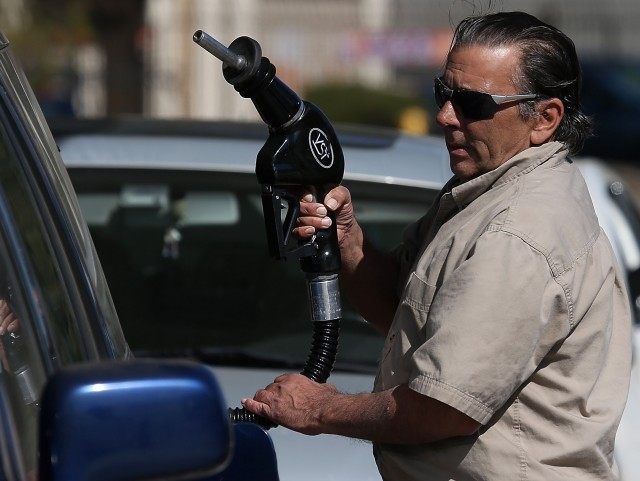REGULATORS PUSH CA GAS PRICE UP TO 80 CENTS HIGHER

California regulators approved a climate change rule on Friday that will push California gasoline prices up to at least an 80 cent premium over the U.S. national average.
Despite Californians already paying $2.999 a gallon for regular gasoline versus a national average price of $2.287 a gallon, the California Air Resources Board (CARB) approved very expensive updates to climate change rules that will force a 10 percent reductions in carbon emissions from gasoline and diesel fuel over the next five years.
Although CARB told the Associated Press that “the economic impact to consumers would be a few cents per gallon, costing a typical commuter $5 to $21 extra in 2017, increasing to $12 to $48 annually in 2020,” CARB has historically underestimated costs.
Gov. Arnold Schwarzenegger promised in 2006 that his Global Warming Solutions Act, known as AB 32, would only cost consumers pennies, annually boost California’s economy by $27 billion, and create an additional 125,000 jobs.
But the California Manufacturing and Technology Association estimates that when AB 32 is fully implemented by 2020, it will have an annual direct cost totaling $35.3 billion, equivalent to about 40 percent of California’s General Fund revenues. Because it will also have cost an estimated 262,000 jobs, California’s 2020 Gross Domestic Product (GDP) will be $153.2 billion lower by 2020.
The latest move follows the January 1 expansion of AB 32’s cap-and-trade program, often referred to as a stealth tax, to include gasoline and diesel transportation fuels. With a carbon market price currently at $12.76/ton, the direct impact of cap-and-trade is to increase gasoline and diesel prices by about $0.14 per gallon. When combined with the 65.98 cents-per-gallon tax, the impact is already almost 80 cents per gallon.
CARB lowered its consumer cost estimates for its latest initiative to reduce carbon in fuel by 10 percent by adopting Gov. Jerry Brown’s narrative that, despite mandatory cutsfailing on a bipartisan basis to pass the state legislature two weeks ago, drivers will now voluntarily reduce fuel consumption by 50 percent on a straight line over the next 15 years.
If drivers do not slash fuel consumption, the additional cost of the regulatory move will start at 8 cents a gallon in 2016 and rise to 26 cents by 2020.
The average American household is expected to save about $550 on gasoline expenditure this year due to the 55 percent plunge in oil prices from last year. That partly explains why the US Bureau of Economic Analysis just reported that U.S. second quarter GDP rose by 3.9 percent.
But California’s GDP was up only 2.3 percent, arguably because the state’s drivers lost almost half the benefit from falling oil prices due to much higher gas taxes and AB 32 cap-and-trade costs. CARB’s new costs will undermine that already weak performance.
Despite having a class of uber rich individuals that make fabulous money on capital gains, California’s average income has fallen since by $5,255 since 2010, and the state’s percentage of middle class households shrank from 46.7 to 43.5 percent of the population. California not only has the highest poverty rate in the U.S. at 23.4 percent, but that rate is now also higher than Greece, at 22.3 percent.
No comments:
Post a Comment